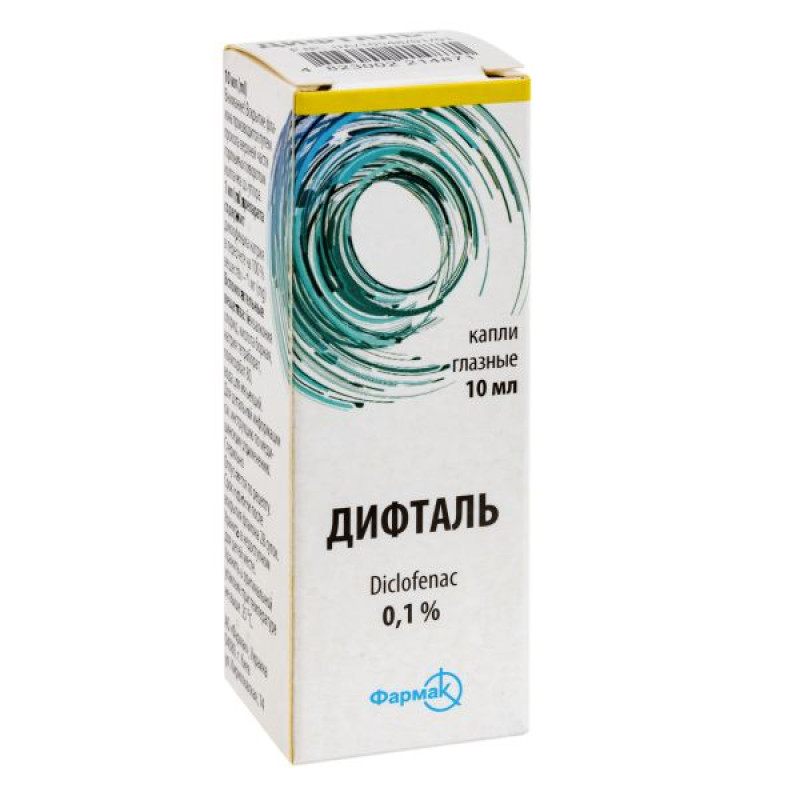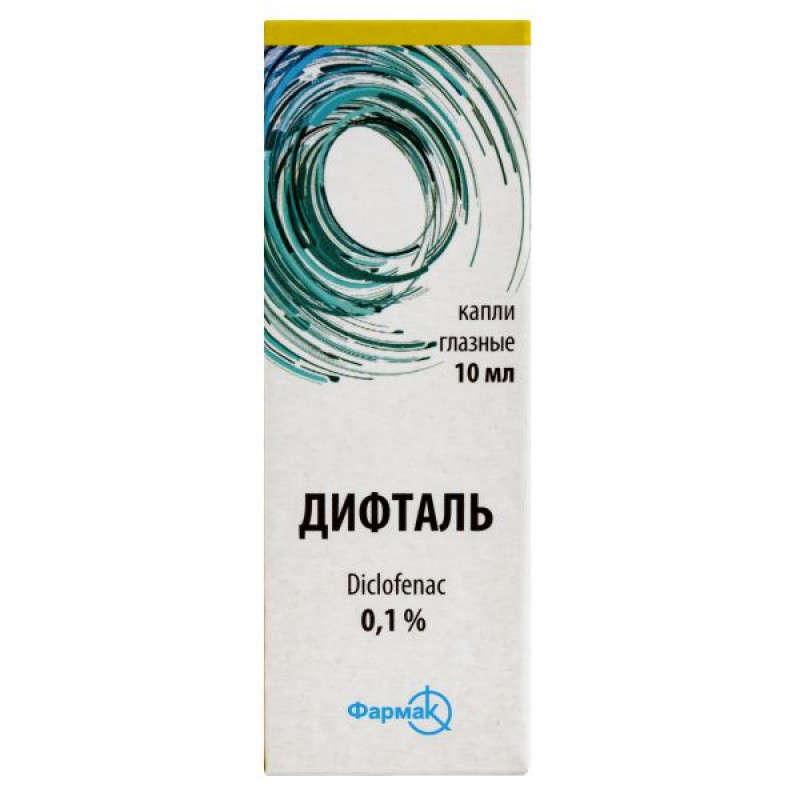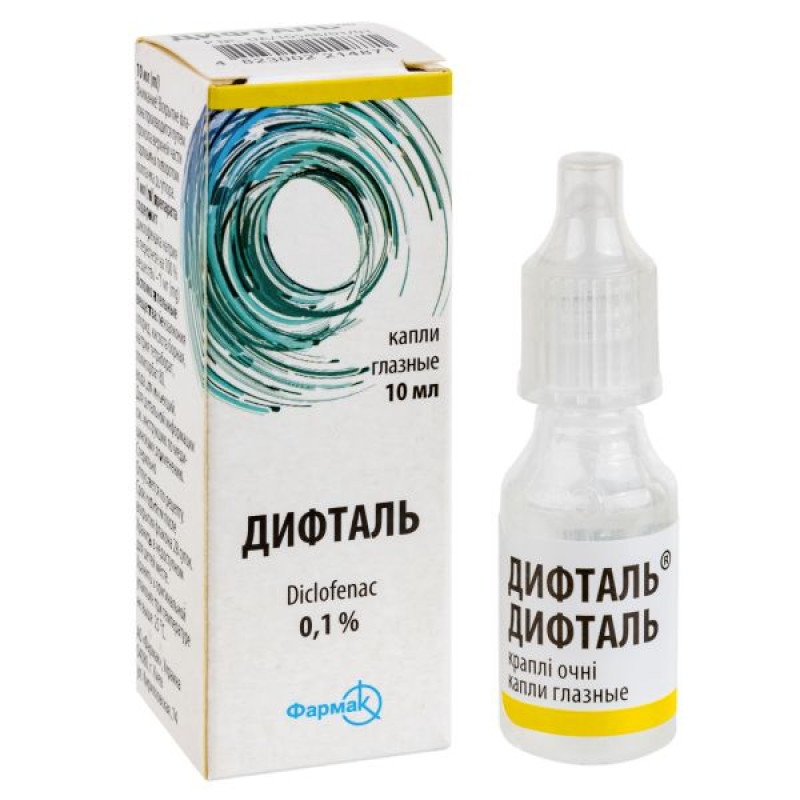Diphtal eye drops 0.1% bottle 10 ml

Diphtal eye drops are used for the following indications:
inhibition of the development of intraoperative miosis during cataract surgery (Diphthaloyl has no characteristic mydriatic properties and does not replace standard drugs that cause pupil dilation); treatment of postoperative inflammation after cataract removal and other surgical interventions; control of the severity of pain and discomfort in ophthalmology associated with damage to the corneal epithelium after Excimer photorefractive therapy (EPRT) or minor non-penetrating trauma; control of the development of the inflammatory process after argon laser trabeculoplasty (ALT); reduction of signs and symptoms of seasonal allergic conjunctivitis (SAC) in ophthalmology; treatment of inflammation and discomfort after surgical treatment of strabismus; treatment of pain and discomfort in ophthalmology after radial keratotomy.Composition
The active substance is diclofenac (1 ml of the drug contains 1 mg of diclofenac sodium in terms of 100% substance).
Excipients: benzalkonium chloride, boric acid, sodium tetraborate, polysorbate 80, water for injections.
Contraindication
hypersensitivity to the active substance or to other components of the drug; like other nonsteroidal anti-inflammatory drugs (NSAIDs), "Diphthal" is contraindicated in patients with attacks of bronchial asthma, urticaria, acute rhinitis associated with the use of acetylsalicylic acid or other drugs that inhibit the activity of prostaglandin synthetase; there is a possibility of cross-sensitivity to acetylsalicylic acid, phenylacetic acid derivatives and other NSAIDs; intraocular use of the drug during a surgical procedure.Method of application
The drug is intended for instillation into the conjunctival sac of the eye only. It should never be administered subconjunctivally, nor should it be administered directly into the anterior chamber of the eye.
The bottle is opened by piercing the upper part of the neck and turning the cap all the way.
Recommended dosage:
prevention of intraoperative miosis - one drop 4 times within 2 hours before the operation; control of the development of the inflammatory process in the postoperative period - one drop 4 times a day for up to 28 days; control of the severity of pain syndrome and discomfort in the period after PRK - one drop 2 times an hour before the operation, one drop 2 times within 5 minutes immediately after PRK, in the postoperative period - one drop every 2-5 hours during the waking period for 24 hours; control of the severity of pain syndrome in ophthalmology associated with damage to the corneal epithelium after minor non-penetrating trauma - one drop 4 times a day for 2 days; control of the development of the inflammatory process after ALT - one drop 4 times within 2 hours before ALT, and then one drop 4 times a day for 7 days; reduction of signs and symptoms of seasonal allergic conjunctivitis in ophthalmology - one drop 4 times a day, lasting as long as necessary; treatment of the inflammatory process and discomfort after surgical treatment of strabismus - one drop 4 times a day for the 1st week, 3 times a day for the 2nd week, 2 times a day for the 3rd week and, if necessary, 4 during the 4th week; treatment of pain syndrome and discomfort in ophthalmology after radial keratotomy: in the preoperative period - one drop before the operation, in the postoperative period - one drop immediately after the operation, then one drop 4 times a day for up to 2 days.Application features
Pregnant women
There are no data on the use of diclofenac sodium during pregnancy. Animal studies with diclofenac have shown reproductive toxicity. I and II trimesters of pregnancy: Animal studies have not shown a risk to the fetus, but there are no controlled studies in pregnant women. This drug should not be used during the III trimester of pregnancy due to the possible risk of premature closure of the ductus arteriosus and possible inhibition of labor.
Diclofenac passes into breast milk, however, the effect of the drug "Diphtal" in therapeutic doses on a breastfed child is not expected. The use of diclofenac in ophthalmology is not recommended during breastfeeding, except when the expected benefit from the drug outweighs the possible risk.
Children
The drug should not be used in children. Experience with the use of diclofenac in this age group is limited to a few published clinical studies conducted in the field of surgical treatment of strabismus.
Drivers
Patients who experience blurred vision should refrain from driving or operating machinery.
Overdose
The risk of developing undesirable effects due to accidental ingestion of the drug is practically non-existent, since a 5 ml bottle of eye drops contains only 5 mg of diclofenac sodium, which corresponds to approximately 3% of the recommended maximum daily dose of diclofenac for oral use.
Side effects
Storage conditions
Store in the original packaging at a temperature not exceeding 25 °C, out of the reach of children.
Shelf life - 2 years (after opening the bottle - 28 days).
There are no reviews for this product.
There are no reviews for this product, be the first to leave your review.
No questions about this product, be the first and ask your question.










